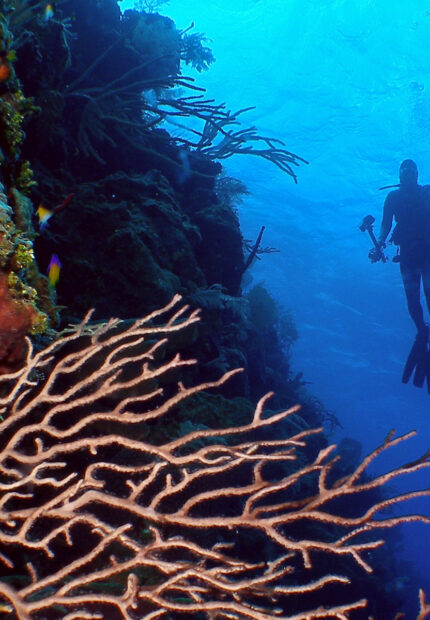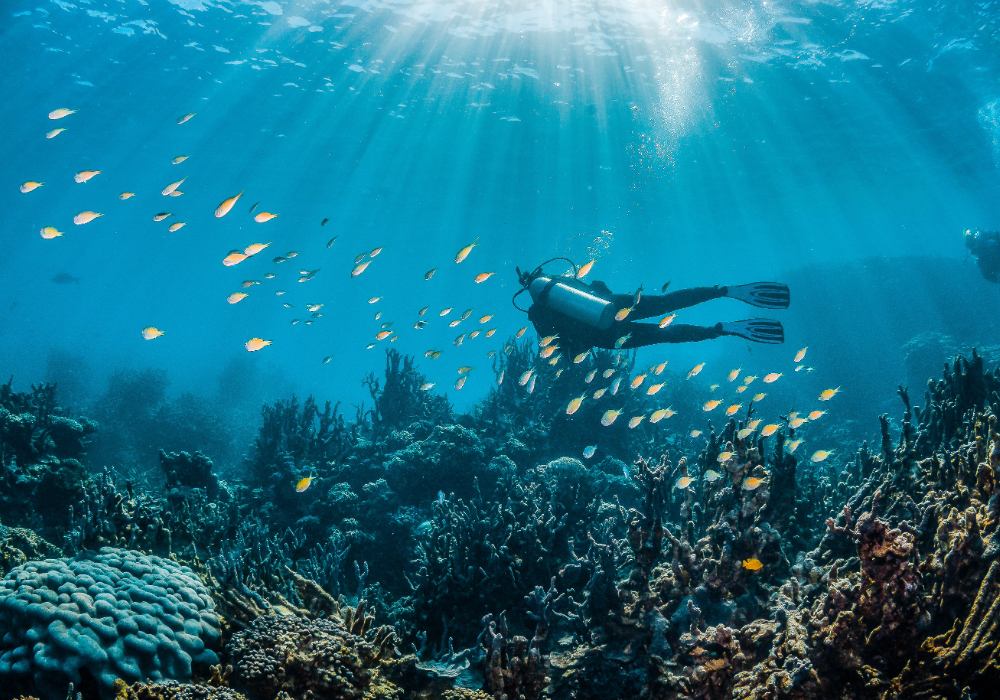
Utila vs Little Corn Islands: Where should I dive in Central America? [2024]
In the heart of the Caribbean Sea lie two sets of stunning tropical islands. Both Honduras’ Bay Islands and Nicaragua’s Corn Islands offer sandy beaches, bright blue seas, and excellent diving and snorkelling. But, if you’re short on time, you might be wondering which one to choose?
Most travellers only have time to visit either the Bay Islands, or the Corn Islands. That’s why I’ve teamed up with one of my favourite travel writers, Sophie Fern! She visited Nicaragua’s Little Corn, I visited Honduras’ Utila, and together we’ll share everything you need to know to help you choose between Utila VS Little Corn, if you can only pick one.
In this blog post, we’ll take a deep dive (pun intended) into the characteristics of each island group, comparing everything from safety and accessibility to diving opportunities and other activities.
Ready? Let’s go!
In a rush? Jump to:
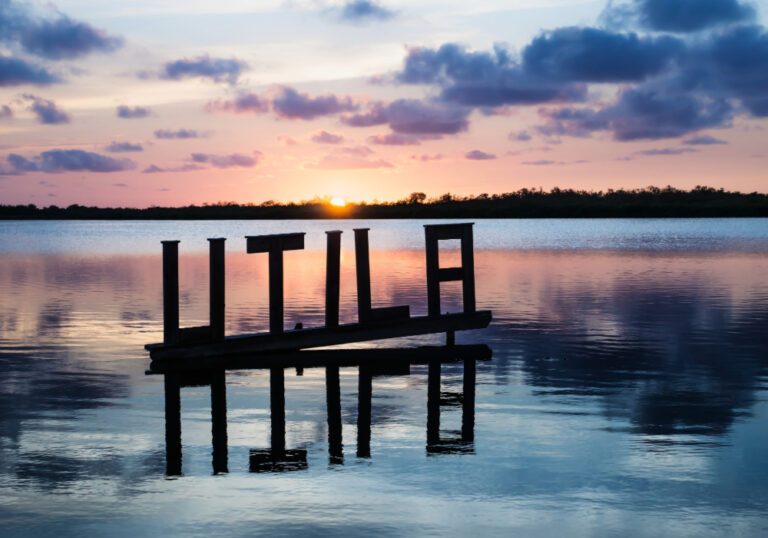
Sunsets in Utila
UTILA VS LITTLE CORN: ABOUT THE ISLANDS
Honduras' Bay Islands:
Comprising three main islands – Roatán, Utila, and Guanaja – the Bay Islands are renowned for their breathtaking coral reefs, diverse marine life, and laid-back Caribbean atmosphere.
Roatán is the largest and most developed of the trio. Full of luxury resorts, Roatán caters to travellers with cash to splash. The smallest island of Guanaja remains relatively untouched by mass tourism, offering secluded beaches and unparalleled diving experiences.
With its rustic charm, Utila is a good compromise between Roatán and Guanaja. Backpackers and budget travellers flock to this small island with its affordable SCUBA diving scene. The island has no cars – just bicycles, golf carts and scooters – and there’s enough going on underwater to keep you busy for as long as you want to stay. I’ll be focusing mostly on Utila from now on, as this was the island I visited!
Nicaragua's Corn Islands:
Located off Nicaragua’s Caribbean coast, the Corn Islands consist of Big Corn Island and Little Corn Island. The Corn Islands are overlooked by many backpackers. This is due to being a lengthy journey away from the well-trodden trail of Nicaraguan highlights along the west coast.
These islands are tiny and remote, but that just means less mass tourism! Big Corn Island is the more developed of the two, featuring a small airport, hotels, and restaurants.
Little Corn Island is a budget traveller’s dream. The island has no motorised vehicles, just the odd bicycle, and everyone knows everyone. Electricity is only on for half of the day and is unreliable at best. This provides the perfect opportunity for a digital detox and allows you to fully relax into the island lifestyle.
Despite being part of Nicaragua, the main language here is English. The food is excellent Caribbean cuisine, focused on a lot of fresh fish and coconut (although I found delicious veggie options too). The local dish is rondon, a creamy stew containing fish, plantain and spices. The budget beach huts are basic but opening your door to white sand and turquoise water definitely evokes a feeling of luxury.
So, what is there to do on this tiny sandy spec? Relax on the glorious beaches. Take a snorkel tour to see turtles, nurse sharks and rays in the crystal clear ocean. Or scuba dive, of course!
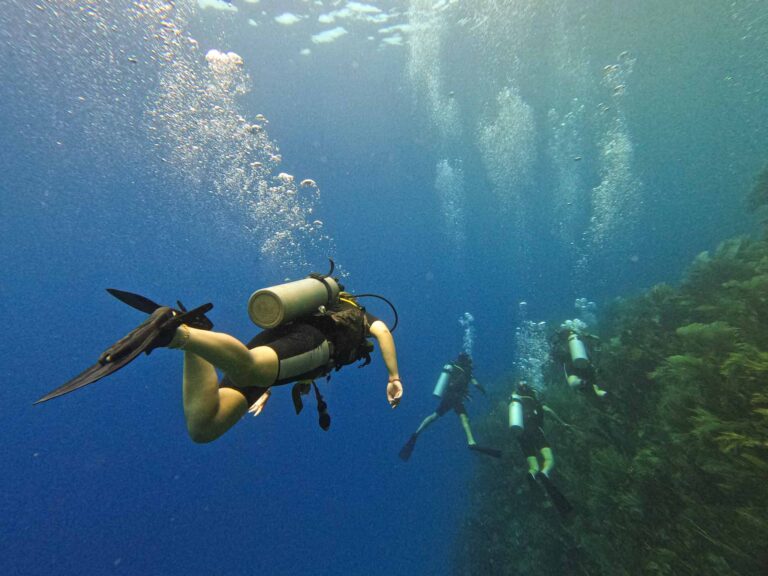
My first ever dive in Utila
UTILA VS LITTLE CORN: WHICH IS SAFER?
When it comes to safety, both Honduras and Nicaragua have experienced their share of challenges in recent years. However, Utila and Little Corn are both considered safe places for travellers.
Honduras' Bay Islands:
The Bay Islands of Honduras have a relatively better reputation for safety compared to mainland Honduras. The crime rates on Utila and Roatán are low, and we felt really secure here. We would walk around, and visit restaurants and bars after dark, which is something we were much more careful about on the mainland. It was nice to be able to let our guard down a bit!
Nicaragua's Corn Islands:
Nicaragua’s Corn Islands are also considered generally safe for travellers. They’re the sort of place where it’s super friendly and everybody knows everybody! However, as with any destination, there are occasional safety concerns related to petty theft or opportunistic crime.
Wherever you travel, it’s important to stay up-to-date with current affairs and exercise caution. As a rule, don’t do anything abroad that you wouldn’t do in your own country.
The Verdict? Utila VS Little Corn: Both islands are considered safe places compared to their respective mainland. You can let your guard down a little, but keep up to date with what’s going on in the country and don’t do anything stupid.

Underwater in Nicaragua’s Little Corn Islands
UTILA VS LITTLE CORN: GETTING TO EACH ISLAND
Getting to Honduras' Bay Islands:
Getting to the Bay Islands is easy. You can either fly from mainland Honduras (here’s why we don’t recommend that), or travel overland (cheap, fun, and better for the planet!).
If you’re travelling overland, the cheapest way to get there is to hop on a bus from San Pedro Sula to the port of La Ceiba. It’s ~$8 USD for a comfortable privately run coach instead of the more dangerous chicken buses, and we’d recommend splashing the extra few bucks here just to be safer.
Once you arrive, there are regular ferries between the mainland and the three Bay Islands. Ferries to Utila leave twice a day, one at 9am the other at 4pm. The cost is ~$55 USD for a return ticket.
There are also private minibuses connecting popular tourist spots across Central America. If you need to travel long distances, these are a great time-saving option. We travelled from León in Nicaragua, directly to La Ceiba, and made it to the last ferry of the day with a cheeky 15 minutes to spare. La Ceiba is sketchy and there is not much to do (especially at night), so try and plan your travel to get the last ferry of the day.
Getting to Nicaragua's Corn Islands:
Getting to the Corn Islands is logistically more difficult, but much cheaper than the Bay Islands!
Your transport choices from the capital city of Managua to Big Corn Island are either a flight to Big Corn Island. Or an overnight bus to Bluefields on the coast, followed by a somewhat hellish 6 to 7 hour ferry. From here you can catch a boat from Big Corn to the more popular, idyllic and you guessed it – smaller – island of Little Corn.
If you travel overland, Little Corn is perhaps the only Caribbean paradise you can get to for as little as $20 (I can confirm that said hellish ferry was worth it) so it’s a budget traveller’s dream!
The Verdict? Utila VS Little Corn: Utila is easier to get to from mainland Honduras but it’s much more expensive (that $55 USD ferry… oof). Little Corn is logistically more difficult to get to, but you can definitely do it on a budget if you’re willing to invest the time.
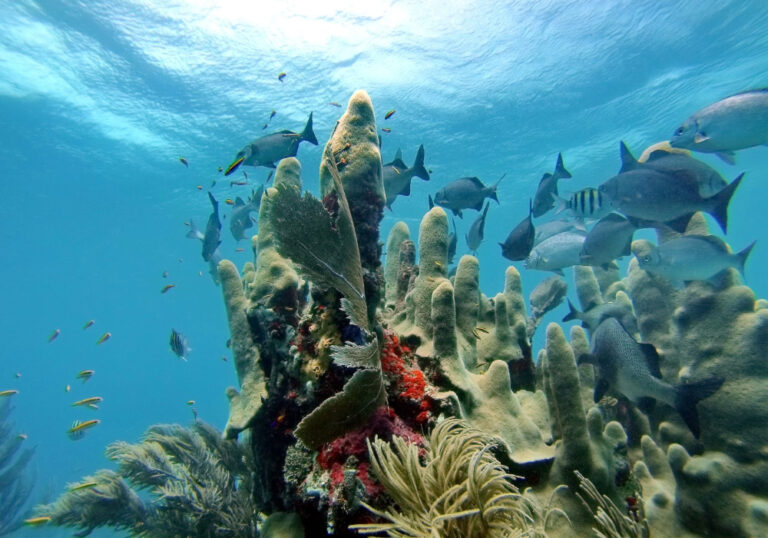
Corals in Honduras’ Utila
UTILA VS LITTLE CORN: WHERE’S BEST FOR DIVING?
Both the Bay Islands and the Corn Islands are renowned for their exceptional diving scene. Set against the Mesoamerican Barrier Reef – the second largest barrier reef in the world – the main attractions of Honduras’ Utila and Nicaragua’s Little Corn are definitely underwater.
Diving in Honduras' Bay Islands:
Utila, in particular, is famous for its affordable dive certifications – it’s one of the cheapest places to learn to dive in Latin America! Every third building (or so) along the shoreline of Utila is a dive school, so it’s easy to find somewhere to get your PADI or SSI qualifications.
There are about fifteen dive shops on the island to choose from. This heavy competition means that most of the shops offer similar rates and packages. Have a chat with travellers who have visited to get an idea of which company to dive with.
The reef boasts stunning coral reefs teeming with colourful corals, fish and rays. We even saw a nurse shark! The waters of the Bay Islands are also known as a place where you can encounter whale sharks, although this is extremely rare. You’re more likely to see whale sharks in Mexico (here’s how!)
If you’re doing a dive course, most of the dive centres throw in a free bed in a dorm room, but these are basic at best. The larger island Roatán offers a more luxurious experience, with upmarket hotels and resorts. And little Guanaja offers a more rustic experience, with secluded dive sites, where you might see more interesting wildlife.
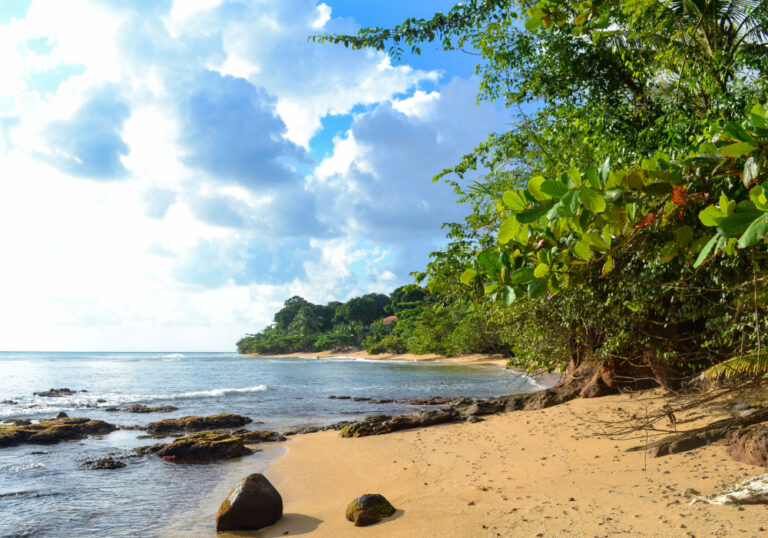
Picturesque Little Corn
Diving in Nicaragua's Corn Islands:
Little Corn Island is also a notoriously cheap place to learn to dive with vibrant coral gardens, underwater tunnels, and abundant marine life on the nearby reef. The island is known for its relaxed diving atmosphere and the chance to spot creatures like eagle rays, nurse sharks, and turtles. There are three diving schools to choose from; Las Palmeras, Oliver’s Dive Little Corn and Dolphin Dive. They offer most PADI courses, including: Beginner OW, Advanced OW, and Dive Master. In addition to fun dives, they offer night dives, photography, and diving packages.
While the diving infrastructure may be less developed compared to the Bay Islands, the Corn Islands offer a more intimate and unspoiled underwater experience. There are also better beaches to hang out on between dives (Utila didn’t really have any!)
The Verdict? Utila VS Little Corn: As a dive destination, Utila definitely beats out Little Corn! Utila is the cheapest place in Latin America to do your SCUBA diving certification. There’s a huge dive scene here, with ~15 dive shops offering almost every PADI or SSI course in the book. But the reef isn’t always as pristine as you might be hoping for. Little Corn has fewer options when it comes to diving, but offers a more intimate and unspoiled diving experience. The beaches are nicer, and the pace of life is slower and more chill.
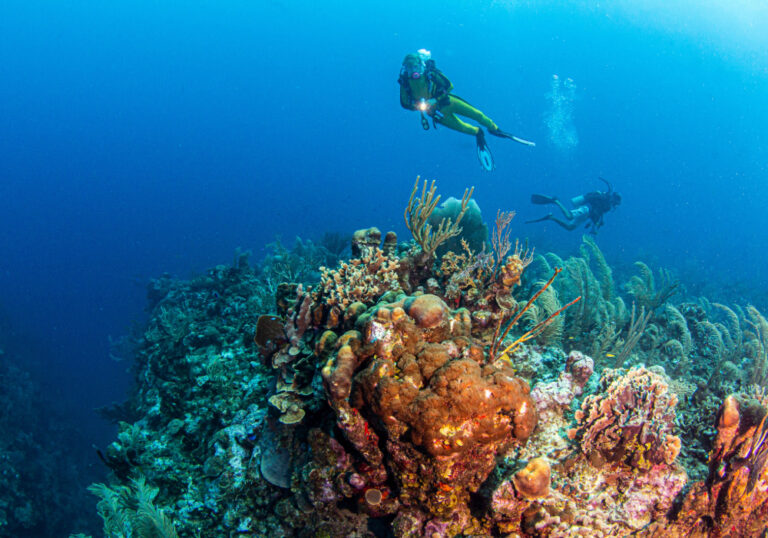
Diving in Utila
UTILA VS LITTLE CORN: WHAT ELSE IS THERE TO DO?
A huge reason to visit Utila or Little Corn is to explore the underwater world. But what else is there to do?
What else is going on: Honduras' Utila
Although most people visit Utila to dive (or learn to dive!), there are a couple of other things to do. Those who don’t dive may enjoy snorkelling, especially if you can grab a spot on a dive boat to take you further out to the reef. Utila also has some beautiful mangrove forests, and a microbrewery, which is a nice place to while away an evening.
Utila is a super social island with a thriving budget backpacker scene. Travellers in their 20’s and 30’s will find it easy to make friends. If you like to party, there’s always something going on. Seven dive centres take it in turns to host a different event every night of the week, from dance parties to beer-pong tournaments, and everyone’s welcome!
So what’s the downside? Well, unless your dive centre/accommodation is lucky enough to have a little patch of sand, you won’t really find public beaches on Utila. The rustic wooden buildings along the shoreline extend out on piers over the ocean. There are two private beaches located on the eastern and western tips of the island, but you have to pay to get there! Utila has lots of beaches on the opposite side to the ferry port, but you will need to rent an ATV to get there, which is expensive too.
This means that there isn’t really a good central place to hang out after a day’s diving. If you don’t want to dive/snorkel, Utila doesn’t have enough going on to keep you entertained for more than a day or so.
In all honesty, if you aren’t interested in diving, drinking, or both, we’d recommend skipping the Bay Islands. There are nicer, beachier islands to visit in Central America. Check out our guides to Panama’s San Blas Islands and Bocas del Toro, or Belize’s Caye Caulker if you’re looking for more of an island getaway.
What else is going on: Nicragua's Little Corn
Being pretty far away from the tourist trail, Little Corn Island is fairly underdeveloped. This gives it some of the most unspoiled beaches in the Caribbean! You can also easily spend a day relaxing on the beaches with a good book and a Nica Libre (rum and cola) in hand.
If you don’t dive, Little Corn Island has some excellent snorkelling. Hop on a dive boat and head out for a cheaper way to explore the reef. You can snorkel for free from the shore. Some of the hostels and hotels along the shore will also let you hire paddle boards by the hour or by the day. This is a really fun way to spend an afternoon if the sea is calm.
So what’s the downside to this postcard-perfect location? The weather. It’s unpredictable, to say the least. There are two ferries per week from the mainland to Big Corn and one per day between the two islands. It’s not uncommon for the wind to prevent the journey from going ahead so it’s probably not the place to come if you have a strict time limit for your trip.
The Verdict? Utila VS Little Corn: Utila is a social island with tons of young backpackers on a budget looking to dive/snorkel all day and party all night. But Utila doesn’t really have many beaches to hang out on. Little Corn is more relaxed, has better beaches, and is the perfect place to relax and unwind. But it’s more logistically difficult to get to, and the weather can stop the twice-weekly ferries making the crossing.
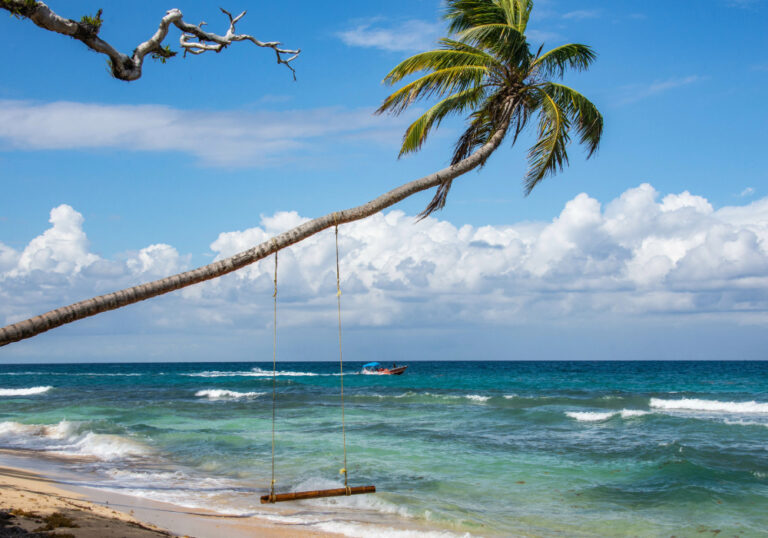
Little Corn has gorgeous beaches!
UTILA VS LITTLE CORN: QUICK VERDICT
Let’s compare:
Utila: Honduras' Bay Islands:
- Diving: There are ~15 dive shops to choose from. The diving is amazing and there are tons of reefs to explore, including a shipwreck at 30m depth! You’ll see lots of fish and lobsters, but not so many large animals (unless you’re very lucky)
- Community: There’s a good international expat community of folk looking to dive and live a simple life. The island is minimal and attracts budget backpackers.
- Social: Definitely a party island. There are lots of bars and restaurants, and a thriving social scene with beer pong tournaments, discos, and DJs.
- Food: There is one big grocery store, so you can cook for yourself if your accommodation has the facilities (most don’t!). There are also lots of restaurants and bars of varying prices.
- Accommodation: Not many places to stay! Most people stay at their dive school’s accommodation.
- Amenities: Minimal, there’s usually electricity/Wi-Fi but not always hot water.
- Logistics: Easy(ish) to get there with public transport. Utila is popular and well-connected to the backpacker route of Central America.
- Nearby: There’s not much to explore on Utila, but nearby Roatán has lots of activities to offer, such as kayaking, paddleboarding, kite surfing, and fishing.
Little Corn: Nicaragua's Corn Islands
- Diving: There are three dive shops with similar prices. The reef is beautiful and there’s lots to see!
- Logistics: Difficult to get there with public transport but worth the trek!
- Community: Little Corn is less of a tourist hot-spot, and the community feels more local, although English is the main language.
- Accommodation: There are both nice upscale bungalows and rustic little beach huts around the island for any kind of budget.
- Food: There’s one general store but there’s not much variety, you can get noodles, rice, or canned goods. If you want to self-cater, bring something from the mainland! There are plenty of restaurants and bars.
- Amenities: The island does not run on electricity for the early part of the day so you feel very much detached from typical Western customs. There’s not always Wi-Fi.
- Social: Laid back Caribbean vibes.
- Nearby: Other water sports including kite surfing, paddle boarding, fishing, and snorkeling are all located nearby.
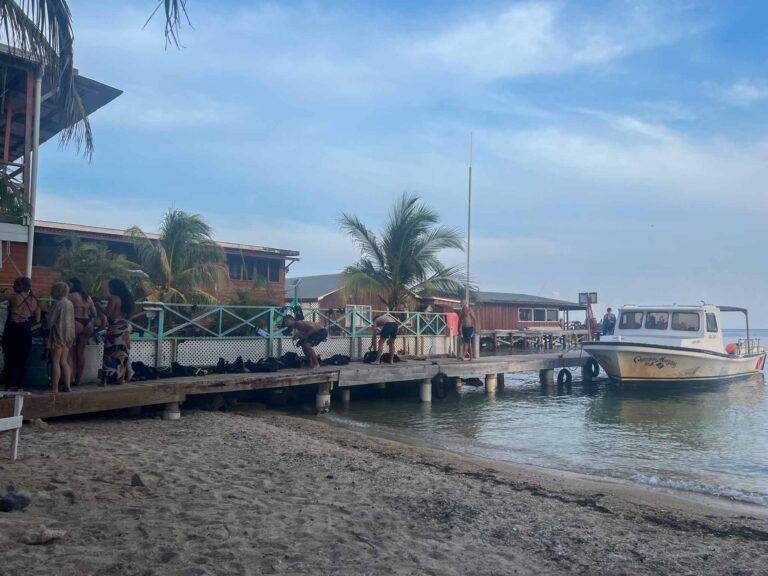
Utila’s beaches aren’t so great… but the diving is!
UTILA VS LITTLE CORN: FINAL THOUGHTS
Both Honduras’ Utila and Nicaragua’s Little Corn are incredible places to dive. The reef is teeming with life, and diving is relatively inexpensive compared to the rest of the world. Both Utila and Little Corn are small and safe islands, with a slow pace of life and laid-back Caribbean vibes.
Honduras’ Bay Islands are more developed, with a more established dive scene. Utila is easy to get to using public transport. The infrastructure caters to large numbers of young budget backpackers looking for cheap diving. But due to Utila’s popularity and Honduras’ lack of regulation (let’s face it, the government has a lot on their plate) the reef isn’t the most pristine in Central America. Unless you’re into diving and/or partying, there’s not really much to do in Utila. The island lacks good beaches, or any accommodation that isn’t attached to a dive centre, so if you’re looking for a laid-back beach vacation, this might not be the island for you.
On the other side, the Corn Islands are less developed, due to their remote location away from Nicaragua’s well-trodden west coast tourist trail (San Juan del Sur, Ometepe Island, Granada, and Leon). Little Corn Island is logistically more difficult to get to, and there’s less infrastructure once you arrive. But this means that the beaches are unspoiled, the reef is pristine, and the island has that tranquil and laid-back vibe.
One thing is certain – a visit to either destination promises unforgettable diving! We think you’d find it difficult to be disappointed in either of these island dive destinations!
Enjoyed this collab? Check out Sophie’s Instagram here for more Central America content!
LIKE IT? PIN IT!
SAVE THIS POST TO YOUR PINTEREST BOARD TO COME BACK LATER

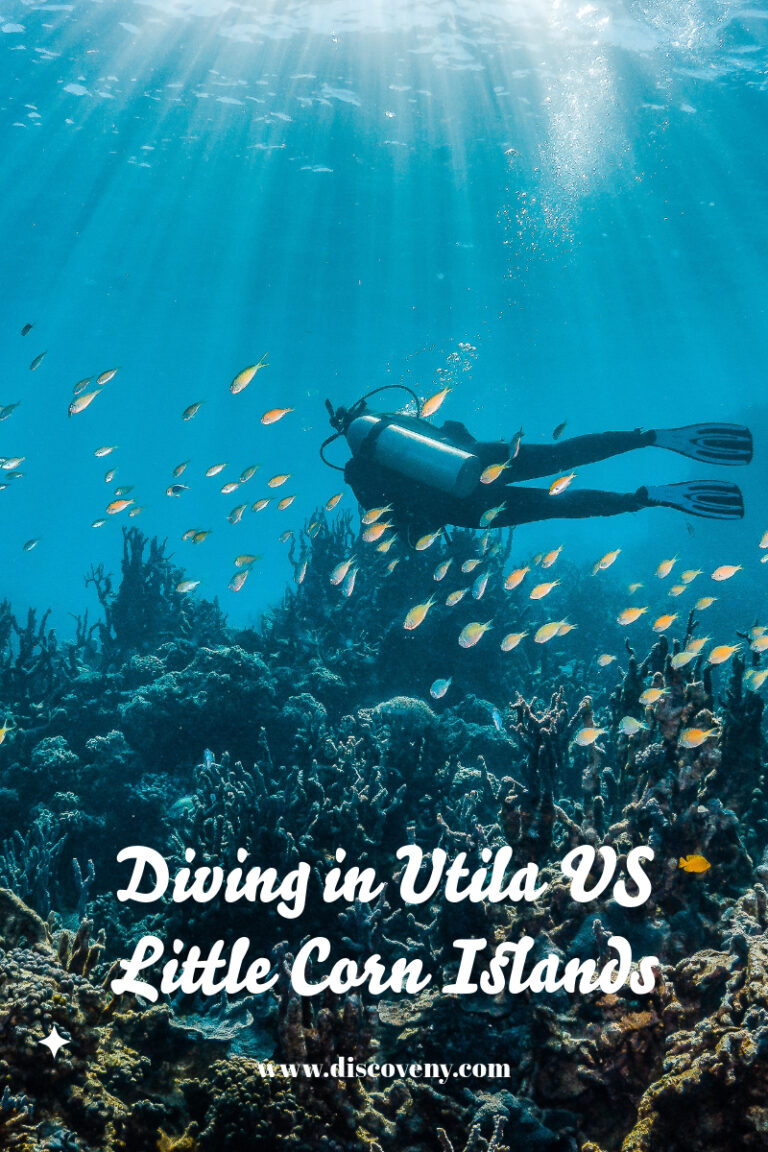
Follow our daily adventures on Facebook and Instagram
Disclaimer: The information and advice provided in this blog are the author’s opinions and based on their personal experiences. All information was accurate at the time of writing. However, things can change quickly, so always double-check current conditions and guidelines before setting out. Remember, your travels and safety are your own responsibility, and this blog can not be held responsible for anything that might happen on your adventures! Always exercise caution and good judgment. Oh, and don’t forget to get travel insurance! Happy travels!
This post may contain affiliate links (yay for transparency!) This means that I will earn a small commission, at no additional cost to you, if you click the link and choose to buy the product. I only link to stuff I have personally bought and found useful and never endorse crap. Your support helps keep the site going, thank you!
Alice
Alice is a UK travel blogger who advocates sustainable travel and being more eco-conscious on a budget. She loves coffee, her houseplants and summiting mountains.
You May Also Like
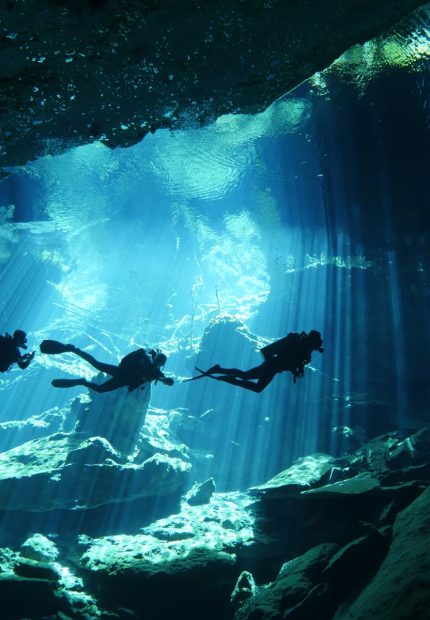
From Mexico to Panama: the ultimate guide to diving in Central America
September 7, 2024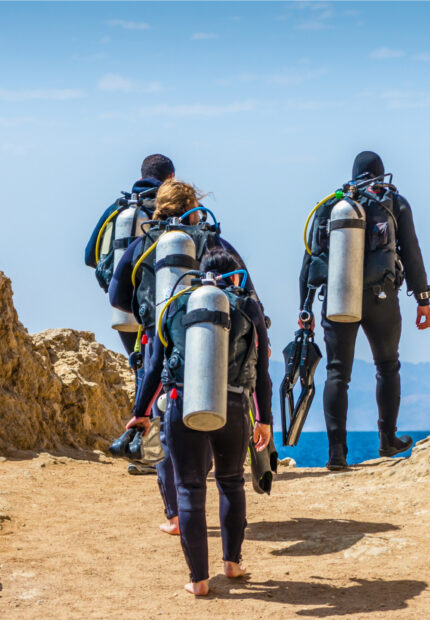
Sharm el Sheikh VS Dahab: Where’s best in Egypt for your Red Sea diving?
June 22, 2024